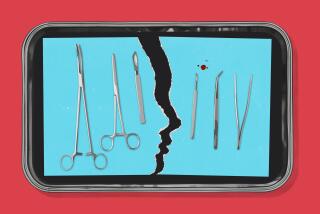Surgeons Fear Effect of Scandal on Training
- Share via
SAN FRANCISCO — There is no better place in the world to fracture a bone this weekend than here.
More than 11,000 orthopedic surgeons -- and nearly 14,000 representatives of companies that make everything from artificial knees to neck braces to shoe inserts -- have been gathering since Wednesday to advance their craft.
Crucial to that task over the years have been cadavers.
Dead bodies are so central in teaching old surgeons new tricks that most people attending the annual meeting of the American Academy of Orthopaedic Surgeons rarely think twice about them. But the body-theft scandal that has unfolded at UCLA medical school over the last week has people in the bone-and-joint-fixing profession talking up one of their most basic training practices.
“You don’t want to have someone invent a product and not try it out first,” said Dr. Robert LaPrade, a specialist in arthroscopy and sports medicine at the University of Minnesota.
Henry Reid, director of the UCLA willed body program, is accused of stealing corpses and selling them to Ernest V. Nelson, who says he cut them into parts and shipped them to biomedical corporations. Both men have been arrested as the investigation continues to explore the scope of the alleged theft. Hundreds of bodies may have been taken.
Some surgeons worried that the scandal, and others like it, could discourage people from donating their bodies for research.
“There are abuses in everything,” said Dr. Bill Tipton, director of medical affairs for the academy. “This gets out into the public and some people tend to overreact.”
There are no cadavers at the conference, which fills the Moscone Center as well as the ballrooms at the Marriott Hotel in downtown San Francisco. In past years, corpses were used to demonstrate surgical techniques, which were projected onto a screen for roomfuls of surgeons to observe. But for logistical reasons, the organizers stopped allowing cadavers two years ago.
So now the surgeons -- mostly men in Dockers and blue blazers -- watch PowerPoint presentations and panel discussions with such titles as “Arthroscopic Evaluation and Treatment of Shoulder Instability” or “Osteochondral Lesions of the Talus.”
They also sit before video screens watching operations as commentary plays over headphones.
And they cruise the conference rooms, where more than 400 companies have set up elaborate displays. Instruments and titanium knees and hips are laid out for the surgeons to fondle. The salespeople explain procedures in such detail that it seems they, too, could perform the operation.
Among the exhibitors is DePuy Mitek, the Johnson & Johnson subsidiary that acknowledged having received body parts from Nelson, the alleged middleman, in the UCLA case, between 1996 and 1999, when the company was known simply as Mitek. Officials have said they “did not knowingly receive samples that may have been obtained inappropriately.”
The company’s sales reps at the conference were instructed not to talk to reporters.
This is not the first time cadavers have gotten bad PR. Body snatchers who supplied bodies to medical schools in the 1800s gave anatomy a bad name.
But as technology advanced, cadavers became increasingly necessary in medicine.
As author Mary Roach pointed out in her 2003 book, “Stiff: The Curious Lives of Human Cadavers,” some people have proved more useful in death than they were in life.
In the surgery field, the trend is toward minimally invasive procedures, which offer better results and swifter recovery. An artificial hip can now be installed with an incision as small as 3 inches.
Such techniques, surgeons say, could not have been developed without cadavers.
“The bodies are being put to good use,” said Dr. Richard Berger, an assistant professor of orthopedics at Rush University Medical Center in Chicago. “We respect them just like a patient.”
Berger performed one operation he helped develop, a minimally invasive hip replacement, on 40 cadaver hips before trying it on a live person.
The next step was teaching other surgeons how to perform it. Again, cadavers were used.
As technology advances, surgeons may find procedures they learned in medical school and residency just a decade ago being phased out.
Some companies at the conference put out fliers advertising hands-on courses utilizing cadavers. Some courses charge doctors more than $1,500 to attend. Others are free, as some firms find enough payoff in the surgeons who will go on to use their parts and instruments.
The surgeons here, for the most part, say they would have no problem willing their bodies to science.
Dr. Buddy Savoie, who practices in Jackson, Miss., plans to do so -- with a caveat. Any parts sent out to research institutions, public or private, must eventually be reunited.
“I’m a Christian and I want to be buried all together,” he said. “If they miss a few pieces, that’s OK. But I want to have a tombstone somewhere.”







